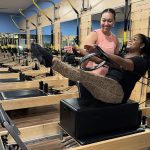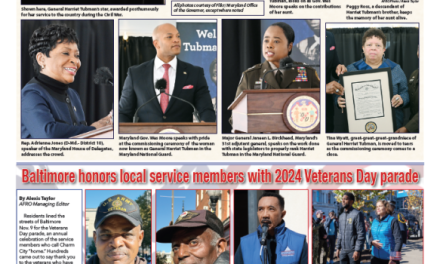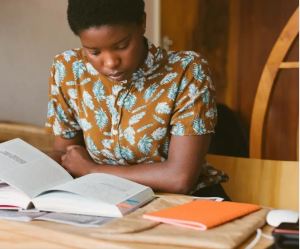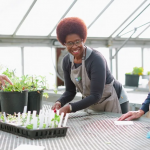Abby Lindley leads Javacia Harris Bowser through a Pilates workout. (Provided)
” data-medium-file=”https://www.birminghamtimes.com/wp-content/uploads/2025/01/Pilates-Javacia-Abby-1-e1738208007637-300×211.jpg” data-large-file=”https://www.birminghamtimes.com/wp-content/uploads/2025/01/Pilates-Javacia-Abby-1-e1738208007637-1024×722.jpg” tabindex=”0″ role=”button” />
By Javacia Harris Bowser | For The Birmingham Times
(An Opinion)
I first tried Pilates for superficial reasons. I saw celebrities like Lori Harvey claiming this method of movement was the secret to their six-pack abs and I thought – sign me up.
But after my first class, I knew that Pilates was going to change my life in ways that had nothing to do with my body’s shape or size. Though I started Pilates hoping to change my body, my practice has, ironically, helped me fall in love with my body as is.
I was reluctant to try a Pilates class at first. I thought everyone else in the room would be skinny, white, 20-somethings. As a size 12 Black woman in her 40s, I would stick out. But after a curvy Black woman in my friend group told me she’d been taking classes regularly I decided to give her studio a try.
To my surprise, at the studio I saw not only other Black women but a variety of body sizes and ages too. Some of the instructors were Black and their body types ran the gamut as well. I didn’t feel out of place at all. Still the perception of Pilates only being for a certain type of body persists.
“I think that there needs to be a lot more diversity in Pilates,” said Abby Lindley, who teaches at Club Pilates in the Greater Birmingham area and Tuscaloosa. She specifically means more body type diversity. One of her favorite fitness influencers to follow is the woman behind the account @FatBodyPilates.
“She is so amazing,” Lindley said. “Props to anyone who posts videos on social media because it’s scary to do, but I think there needs to be more people like her.”
It was Lindley’s love for dance that drew her to Pilates.
“I started dancing when I was three and I’ve danced my whole life — competition teams, studio stuff, tap dance, ballet, hip hop — all the things,” she said. But after graduating from Pelham High School, Lindley wanted to find another way to move her body as she was studying exercise science at the University of Montevallo.
After seeing someone practicing Pilates on TikTok, Lindley searched for a nearby studio to give it a try. With just one class at Club Pilates, she was hooked because the movements of Pilates were so similar to the movements she grew up practicing as a dancer.
“I was like, ‘This is what I know and I’m good at it!’” Lindley said with a laugh.
Black Women and Pilates
Here’s a quick history lesson on Pilates: Joseph Pilates developed the technique in the 1910s and 20s in part while he served during the First World War as an orderly in a hospital on Isle of Man. Working with patients who were unable to walk, he put springs on the hospital beds to help support the limbs of the wounded soldiers. Much of the equipment he used would be adapted into the machines used in Pilates classes today.
But my notion that there was no place for me in Pilates as a Black woman couldn’t have been further from the truth. In fact, one of the most revered Pilates instructors was a Black woman.
Dancer and choreographer Kathleen Stanford Grant (1921 – 2010) studied directly under Joseph Pilates and taught the Pilates method for more than 50 years. She first began working with Pilates after a dance injury and eventually created Before the Hundred, a technique designed to prepare the body for the Pilates exercises. In the Pilates world, Grant is not only considered a first-generation Pilates teacher but is also revered as a pioneer and innovator.
My Pilates Body
After practicing Pilates for a year and a half, I consider it an essential act of self-care. Yes, it’s a great form of strength training but for me it’s so much more.
When I’m in class I can’t worry about work deadlines, family drama, or even the size and shape of my body because I’m focused on breathing and following the instructor’s cues. Outside of the Pilates studio I am the person everyone always turns to for help but in class, I relish getting help from the instructor as she assists me in positioning my body and equipment properly to perform the exercises safely.
In Pilates I’m focused less on what my body looks like and more on what it can do.
“I want people to realize that they’re a lot stronger than they think,” Lindley said when asked what she wants most for her Pilates students.
“When you first start taking classes you don’t know what the heck you’re doing, but the stronger you get, the more you realize how much you are actually capable of,” Lindley added.
That said, she also believes that Pilates can help you let go of perfectionism.
“Pilates is a practice,” she said. “You want to keep pushing yourself to be better, but you’re never going to the best of the best. But that means there’s always something to look forward to.”
Because I believe self-care is self-love in action, I am showing love for my body every time I show up for a Pilates class. And in class, I can push myself to get better without beating myself up for not being perfect.
Communication is key in any love relationship and Pilates has taught me how to listen to my body. So I can make better choices about what and when to eat and how much, and decisions about when to exercise and when to rest.
I celebrate my body when I do something in class that I couldn’t do before the week before. But even when I attempt something and can’t quite pull it off, I still celebrate my body simply for keeping me alive. To me this is what it means to be body positive.
Javacia Harris Bowser is a regular contributor to The Birmingham Times and the founder of See Jane Write, a website, community and coaching service for women who write.











